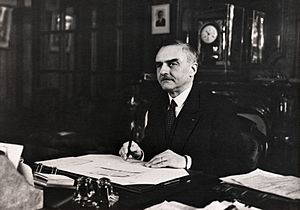André-Louis Danjon facts for kids
Quick facts for kids
André-Louis Danjon
|
|
|---|---|
 |
|
| Born | 6 April 1890 |
| Died | 21 April 1967 (aged 77) |
| Nationality | French |
| Known for | Danjon scale |
| Awards | Gold Medal of the Royal Astronomical Society in 1958 |
| Scientific career | |
| Fields | astronomy |
André-Louis Danjon (born April 6, 1890 – died April 21, 1967) was a famous French astronomer. He was born in Caen, a city in France. Danjon made many important discoveries and inventions that helped us understand the stars and planets better.
Contents
Measuring Moonlight: The Danjon Scale
One of André-Louis Danjon's cool inventions was a way to measure "earthshine" on the Moon. Earthshine is the faint glow you sometimes see on the dark part of the Moon. It's actually sunlight reflecting off Earth and then hitting the Moon.
How Danjon Measured Earthshine
Danjon used a special telescope for this.
- He had a prism inside the telescope. This prism split the Moon's image into two identical pictures, side by side.
- He would then dim one of the Moon's images using a special tool called a diaphragm.
- He kept dimming it until the bright, sunlit part of that image looked just as bright as the faint, earthlit part of the other image.
- By measuring how much he had to dim the image, he could figure out exactly how bright the earthshine was.
The Danjon Scale
He recorded these measurements from 1925 all the way into the 1950s. Today, this method is known as the Danjon scale. On this scale, a zero means the Moon is barely visible.
The Danjon Astrolabe
Danjon also designed a very important tool called the "impersonal (prismatic) astrolabe". This was an improved version of an older astrolabe.
What an Astrolabe Does
An astrolabe is an old instrument used by astronomers to measure the positions of stars and other celestial objects. Danjon's new design made these measurements much more accurate. This helped astronomers get better information about where things are in space.
Why it was Important
He explained how his astrolabe worked and what they learned from it in a special lecture in 1958. This lecture was given to the Royal Astronomical Society, a very important group of astronomers.
The Danjon Limit
André-Louis Danjon also thought about something called the "Danjon limit." This was an idea about how far away the Sun and Moon need to be from each other in the sky for us to see a tiny crescent of the Moon. However, scientists now think that this exact limit might not actually exist.
His Career and Awards
Danjon led some very important observatories in France.
- He was the Director of the Observatory of Strasbourg from 1930 to 1945.
- Then, he became the Director of the Paris Observatory from 1945 to 1963.
He was also the President of the Société astronomique de France (SAF), which is the main French astronomical society. He held this position twice: from 1947 to 1949 and again from 1962 to 1964.
Danjon received several important awards for his work:
- In 1950, he won the Prix Jules Janssen from the French astronomical society.
- In 1958, he was given the Gold Medal of the Royal Astronomical Society, which is one of the highest honors an astronomer can receive.
André-Louis Danjon passed away in 1967 in Suresnes, France.
See also
 In Spanish: André-Louis Danjon para niños
In Spanish: André-Louis Danjon para niños

